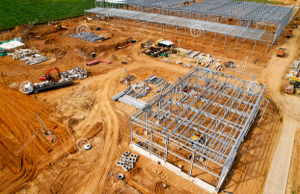Steel in Structure

The building structure is the main element that makes the building durable and solid. Preferences regarding the building system will be of vital importance at this point. The material chosen for the durability or life of the building is the most important of these choices. Steel is a material known for its high durability. Being both flexible and light makes the structures strong.
Strength is not the only advantage of the steel structure, relieves the load on the steel foundation and reduces the need for columns. Since the skeleton of the building to be built is prepared in advance, it is built quickly. It is preferred in areas with high earthquake risk because it responds to earthquake waves by stretching, not by breaking like concrete. Thanks to its light and homogeneous structure, the damages caused by earthquakes in steel construction structures are much lower. Steel, which has advantages and disadvantages, is a material with a low resistance to fire. It is affected by heat quite easily, but fire protection measures are developing every day. There are fire protection methods such as sprinkler systems, detection and alarm systems, and passive fire protection systems.
Where is Steel Construction Used?

Steel construction is called structures with all carrier systems made of steel. The most used areas of steel structure are industrial buildings, hangars, large span bridges, and roofs. The main reasons for its use in these areas are that steel can be produced as desired thanks to its homogeneous material property that can show elastic behavior and that it allows wide column-free and beam-free openings. Today, it has begun to be seen in different types of buildings such as residences, shopping centers, and business centers.
Steel Structure Types
Steel structures are divided into two, heavy steel and light steel construction structures.

Light Steel: As the name suggests, it is light compared to traditional steel elements. It has different nuances from structural steel in its forming, fabrication, assembly, design, and calculations. For example, cold forming can be applied to light steel. Light steel structural elements are produced from sheets. Pressing and cold rolling are the two main methods to give the sheets this shape. Another nuance is the use of specially shaped profiles in the construction of light steel structures. Light steel can be seen in the construction of temporary structures, large-scale projects that need to be produced in a short time, freight containers, and prefabricated workshop and warehouse structures.
Heavy Steel: Unlike cold forming in light steel, heat treatment and rolling is performed. Heavy steel is seen in structures with large openings and factory buildings. It is not as easy as light steel in manufacturing and assembly.
Contribution of Steel to the Sustainability

Before its contribution to recycling, it stands out with the low material waste in production. With the steel produced in the workshops before the construction site, there is almost no loss. It can be used in other construction sites if the parts are dismantled. It has scrap value if it cannot be used and needs to be recycled. İt has been reported by the American Iron and Steel Association that steel is a material suitable for recycling at a rate of 90% or more and certified by International Environmental Management Systems.
When we compare it with other materials, we see that when a reinforced concrete structure is demolished, it has a large negative impact on the environment, while the negative impact of the steel structure during disassembly is very low. There are many different evaluation criteria, apart from recycling when deciding whether a building is sustainable or not. Environmental impact, disposal, durability, and emissions are examples of these. The steel industry has improved its production methods and minimized the environmental impact. As a result, steelmaking has become more energy efficient over time.

